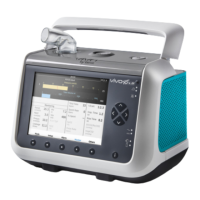Risk of Faulty Treatment
Do not use the Vivo 45 LS in the event of:
• Suspected damage to the device, including the occurrence of Internal Functional
Failure alarms.
• Unexpected patient symptoms during treatment.
• Unexplainable or sudden changes of pressure, performance or sound during
operation.
• Delivered air being abnormally hot or emitting an odor.
Contact your responsible care provider for an inspection.
Risk of Faulty Treatment
The responsible organization should periodically reassess the settings of the therapy
for effectiveness.
The ventilator therapy settings must always be based on medical advice and must be
carried out by authorised clinical personnel only. When changing treatment settings
or changing to another device a clinical assessment must be performed to determine
if blood gas measurement needs to be performed.
Before starting treatment, always perform the procedure 4.5 Inspecting the Vivo 45 LS
before Use , page 50.
Risk of Unnoticed Critical Conditions
• The alarm sound level should be set to a clearly audible level. Setting the alarm
sound level below that of the ambient sound level can impede recognition of
alarm conditions.
CAUTION!
Clinical personnel must read the Clinician’s manual thoroughly and understand the
ventilator operation before setting up and using the ventilator.
• Handle the ventilator with care.
• Do not use the ventilator while in the carry bag.
• Do not use the ventilator with nitric oxide, helium or helium mixtures.
Contact Injuries: Skin irritation may occur due to prolonged exposure to either a
mask (if used) or the SpO
2
module.
Safety Information 21
Doc. 007301 K-1 User manual

